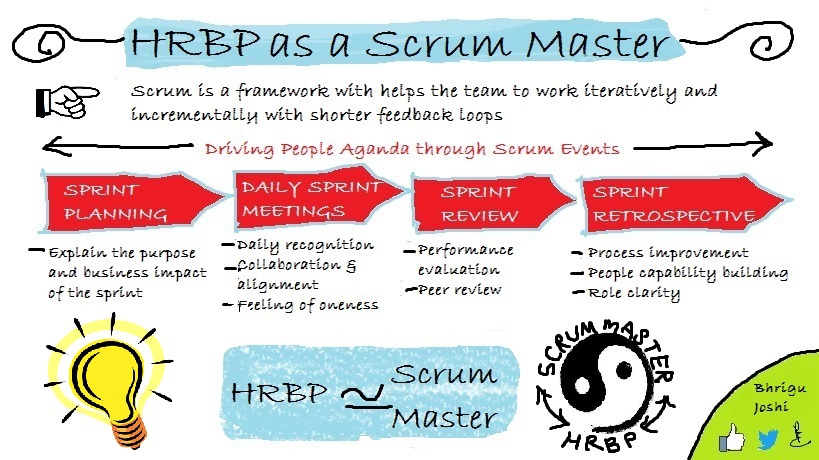For those who are new to scrum, it is a framework, which helps the team to work iteratively and incrementally with shorter feedback loops.
Ways of working in the tech world are undergoing a rapid shift. Uncertainty has become the new normal, especially in the tech product companies. As information is only progressively discovered during the product development lifecycle, the traditional predictive ways of working have given way to new adaptive ways. Now we only plan for a short period, create a working product, get the feedback from the customer and use that feedback to plan further. Such adaptive ways of working are called ‘agile’; and one of the most popular agile frameworks is Scrum.
For those who are new to scrum, it is a framework, which helps the team to work iteratively and incrementally with shorter feedback loops. This helps in frequent course correction, based on changing realities. Scrum was developed as a way to handle the fast pace of technological change. Each scrum team consists of cross-functional and self-organising members, who work towards a shared goal at any given point in time.
The scrum framework consists of four formal events—sprint planning, daily scrum meetings, sprint review and sprint retrospective, enveloped within a cycle called ‘Sprint’. Each sprint can be considered as a project, with a time horizon as short as two to three weeks. Each event in scrum is a specific forum, wherein the team members come together (in person) to realise the following objectives:
• Sprint planning: The scrum team unites to plan the items they intend to deliver in the upcoming sprint, and the manner in which they want to deliver those items.
• Daily scrum meeting: The development team meets daily for 15 minutes, to coordinate their work for the next 24 hours.
• Sprint review: The development team reviews the outcome of the sprint, with the customers, to receive feedback.
• Sprint retrospective: The development team holds a meeting to review the process for the next sprint.
Each scrum team has a designated scrum master. The role of the scrum master is to ensure that the principles of scrum are well understood by the team, and also to facilitate the execution of the above-mentioned scrum events.
Like in any other team, success of the scrum team depends upon the sustained engagement, learning, collaboration, alignment and motivation of its team members. HR Business Partners (HRBPs) in most organisations are entrusted to drive this people agenda, along with the business leaders. In this pursuit, many times HRBPs create separate HR events, such as learning sessions, performance review meetings, team gatherings, monthly/quarterly awards, leadership talks, and so on, to drive the aforesaid people agenda. The big question here is—Can we merge the HR events with the scrum events to create synergy? The answer is a definite ‘yes’! It will not only make HR events more consequential for business, but it will also reduce the multiplicity of forums. Following are some of the ways through which HR can bake the people agenda in the scrum events.
Sprint Planning

This can be used as an opportunity to involve all the cross-functional team members and collectively discuss the desired sprint outcome and ways of achieving them. Also, it’s a great opportunity to explain the purpose of the sprint and its business impact to the entire scrum team. Autonomy of decision making and alignment with the purpose are known to be the two most significant drivers of employee engagement.
Daily Scrum Meeting
Team members get a chance to share what they have done in the last 24 hours, their plan for the next 24 hours and what help they require from others. These daily stand-ups can also be used to recognise team members who did a great job and create a sense of appreciation for others within the team. It is also a great opportunity to continuously collaborate with each other and sustain the feeling of one team.
Sprint Review
This is a great chance for the team to collectively evaluate the performance of the sprint with the customers. Shorter feedback loops help the team to stay on track and sustain its motivation to outperform itself. Also, doing peer review at this stage may help individual team members get the relevant feedback from others to improve themselves.
Sprint Retrospective
As the name suggests, it is an opportunity to identify all the areas of improvement, while working in the sprint, such as, process, people capability, roles and culture. Specific short interventions can be designed to fix the problems encountered in each successive sprint. This is the event in which maximum on-the-job learning can happen.
HRBPs have a huge responsibility to work closely with the scrum teams to embed the above mentioned people agenda in the scrum events. As with scrum masters, HRBPs will also have the responsibility to participate in various scrum events and drive discipline around executing them. With these expectations, the roles of the HRBPs and the scrum masters are likely to converge. This will not only make the work of HRBPs more meaningful, but the arrangement will also add immense value to the business. HRBPs, along with other leaders, will now be responsible for curating high-performing work culture within each scrum team. However, I must admit that HRBPs may initially require some training on the scrum principles. Certification from Scrum.org or other similar professional bodies may help them in this regard.
With the changing dynamics in the tech product world, the line between HR and business will blur, and this is definitely great news! It offers an opportunity for the HR function to shift from being the enabler of the business to being the business itself!
(The author is associate director – business HR at MakeMyTrip Group)



